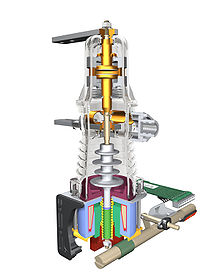Vacuum switch

In electrical power engineering, a vacuum switch is a type of circuit breaker in which the contacts to reduce the undesired switching arc are under vacuum . These switches are preferred for medium-voltage switchgear with voltages up to approx. 40 kV .
General
Vacuum switches have a very large number of switching cycles while being largely maintenance-free over several decades and, depending on the type, can switch short-circuit currents over 60 kA. They are used, for example, in switching cells in the medium-voltage network and in the area of electric railways as load switches. The switching contacts located in the vacuum are driven electromagnetically or via a mechanical linkage. The contact distance is only a few millimeters when open.
Since there is no gas in the contact area which could be ionized during the switching process , only a comparatively small metal vapor arc occurs when the contact is opened, which is fed from the evaporated surface material of the contacts. Two methods are used to extinguish the metal vapor arc with this type of switch:
- The contacts, made in the shape of a punch in the form of a wide cylinder and made of solid metal, represent a good heat sink, which removes heat from the metal vapor arc and allows the metal vapor to condense on the contact surfaces by cooling. This "material reuse" in the contact area is the primary reason for the long service life and freedom from maintenance. In the case of AC voltage, the arc is extinguished as a result of the condensation of the metal vapor at the next zero crossing of the current.
- To avoid very hot current constrictions and to achieve a distribution in partial arcs that is as uniform as possible over the entire contact surface, which also supports cooling, inclined slots are milled into the cylindrical contacts around the circumference. At high currents, due to the magnetic effect on the arc, these generate a force which causes the arc to rotate around the contact axis and thus spatially distributed over the contact surface. This shape of the contacts is particularly important when interrupting very high currents, such as those that occur with short circuits.
There are also vacuum contactors with a similar structure, which are activated by a single permanently activated coil.
Individual evidence
- ↑ Switching with vacuum circuit-breakers. (PDF; 1.0 MB) Siemens, accessed on September 10, 2013 .
- ↑ Vacuum interrupter chambers with axial magnetic field contacts for medium-voltage switches. (PDF; 318 kB) ABB, January 2000, accessed on September 10, 2013 .
literature
- Adolf J. Schwab : electrical energy systems. Generation, transport, transmission and distribution of electrical energy . 2nd updated edition. Springer, Berlin et al. 2009, ISBN 978-3-540-92226-1 .
